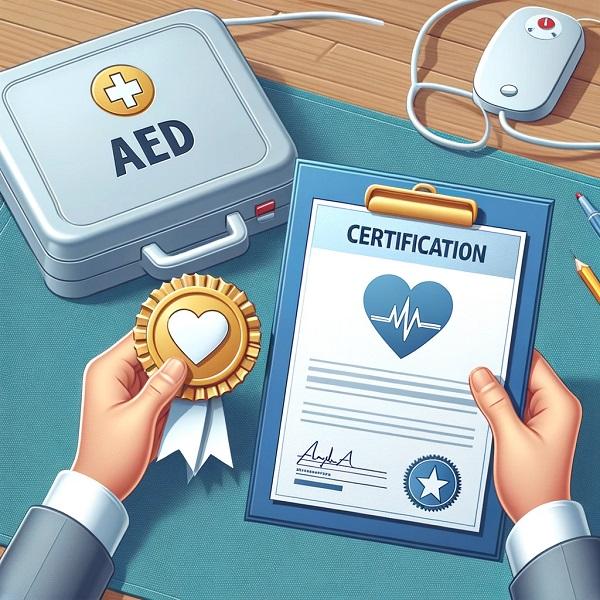The Key to Saving Lives
In today’s fast-paced world, emergencies can happen at any time, and having the skills to respond effectively can mean the difference between life and death. One of the most critical skills to possess in an emergency situation is the ability to perform CPR and operate an Automated External Defibrillator (AED). These skills can be acquired through AED certification courses, which provide individuals with the knowledge and training necessary to respond to cardiac emergencies. In this comprehensive guide, we will explore everything you need to know about getting your AED certification, including the benefits, the certification process, and the importance of staying current with your certification.
Understanding AED Certification
An AED certification demonstrates that an individual has successfully completed a training program that covers the proper use of an Automated External Defibrillator. AEDs are portable devices that deliver an electric shock to the heart in order to restore normal rhythm during sudden cardiac arrest. AED certification courses are designed to teach individuals how to recognize and respond to cardiac emergencies, perform CPR, and effectively use an AED.
The Benefits of AED Certification
The benefits of obtaining AED certification are numerous and far-reaching. One of the most significant advantages is the ability to save lives in the event of a cardiac emergency. The average response time for first responders once 911 is called is 8-12 minutes, and for each minute defibrillation is delayed, the chance of survival reduces by approximately 10%. With AED certification, individuals can step in and provide life-saving care until professional help arrives, significantly increasing the chances of survival for the victim.
Additionally, AED certification provides individuals with the confidence and knowledge to respond calmly and effectively during high-stress situations. By completing an AED certification course, individuals gain the skills necessary to assess a situation, perform CPR, and use an AED, ultimately making a positive impact on the outcome of a cardiac emergency.
AED Certification Process
The process of obtaining AED certification typically involves completing a training course that covers CPR, AED usage, and other relevant emergency response techniques. These courses can be completed in various formats, including in-person classes, online courses, and blended Simulation Learning, which combines online information with hands-on skills sessions. The flexibility of these training options allows individuals to choose the format that best suits their schedule and learning style.
During the certification course, participants will learn how to recognize the signs of sudden cardiac arrest, perform CPR, and operate an AED. The course may include live-action videos, interactive computer-generated animations, and practical demonstrations to ensure that participants have a comprehensive understanding of the skills and techniques involved. Upon successful completion of the course, participants will receive a certification card that is valid for two years.
Staying Current with Your Certification
After obtaining AED certification, it is essential to stay current with your training and certification. The American Red Cross CPR/AED certification program includes a recertification component for current certificate holders, allowing individuals to renew their certification and stay up to date with the latest information and techniques. Additionally, the certification period provides access to online refresher materials, ensuring that individuals can review and reinforce their skills as needed.
Benefits of Online AED Certification
Online AED certification courses offer several benefits, making it a convenient and effective option for individuals seeking to obtain or renew their certification. Online courses provide an easy learning format that allows participants to learn at their own pace. The courses often include video demonstrations that can be replayed as often as needed, interactive graphics, and a relaxed learning atmosphere, creating an optimal environment for skill acquisition.
Furthermore, online AED certification courses offer flexibility and accessibility, allowing individuals to complete the training from the comfort of their own homes or at a time that best fits their schedule. This flexibility is especially beneficial for busy professionals, healthcare providers, emergency response teams, and individuals with demanding schedules, as it eliminates the need to adhere to a specific class schedule.
Recertification and Continuing Education Credits
In addition to the initial certification process, AED certification programs often include opportunities for recertification and the ability to earn continuing education credits. Recertification allows individuals to renew their certification and extend their credentials for an additional period, ensuring that they remain equipped to respond to cardiac emergencies effectively.
Furthermore, many AED certification programs are approved to award Continuing Education Units (CEUs) in courses related to Preparedness and Health and Safety Services. These CEUs can be beneficial for professionals in various fields, such as nurses, first responders, social workers, teachers, and healthcare providers, allowing them to maintain their professional credentials while gaining valuable knowledge and skills.
Conclusion
Obtaining AED certification is a valuable investment in your ability to respond effectively to cardiac emergencies and potentially save lives. The skills and knowledge gained through AED certification courses are indispensable, providing individuals with the confidence and capability to make a difference in critical situations. Whether completing the certification for the first time or seeking recertification, online AED certification courses offer a convenient and accessible pathway to acquiring and maintaining these essential skills.
By staying current with your AED certification and taking advantage of recertification opportunities, you can ensure that you are prepared to respond to cardiac emergencies with confidence and competence. The ability to recognize and respond to sudden cardiac arrest can make a significant impact on the outcome of an emergency, and AED certification equips individuals with the necessary skills to be a positive force in such situations.
In conclusion, getting your AED certification is not only a valuable personal investment, but it is also a commitment to the well-being and safety of those around you. The knowledge and skills acquired through AED certification have the potential to save lives and make a meaningful difference in emergency situations. Therefore, taking the steps to obtain and maintain AED certification is a crucial aspect of being prepared to respond effectively to cardiac emergencies and contribute to the well-being of your community.










